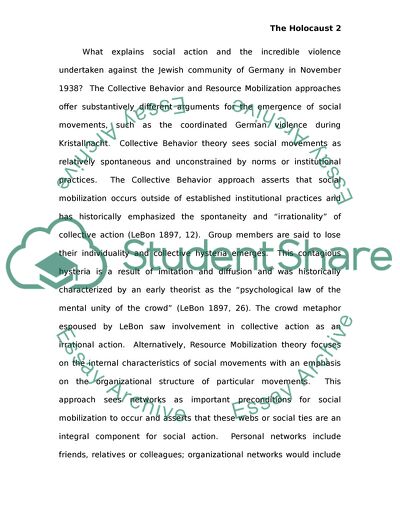
- Home
- Free Samples
- Premium Essays
- Editing Services
- Extra Tools
- Essay Writing Help
- About Us
- Studentshare
- Subjects
- Miscellaneous
- Was the kristallnacht a planned event by the Germans or spontaneous
Was the kristallnacht a planned event by the Germans or spontaneous - Essay Example

- Subject: Miscellaneous
- Type: Essay
- Level: Masters
- Pages: 4 (1000 words)
- Downloads: 0
- Author: nitzscheward
Extract of sample "Was the kristallnacht a planned event by the Germans or spontaneous"
On November 9/10 1938, a violent assault against the Jews of Germany was undertaken with impunity. The Kristallnacht occurred in response to the murder of a German Embassy staff member in Paris, allegedly undertaken by a Jew, and resulted incredible violence directed against the Jews leading to the near complete destruction of the visible Jewish community in the Third Reich. Was the Kristallnacht spontaneous or a coordinated event aimed at destroying the Jews of Germany? The following will persuasively argue that this event was not spontaneous but was planned from above.
This event remains important because it was one of the earliest violent episodes of state-led violence against the Jews of Germany and paved the way for the Holocaust. (Dawidowicz, 1976, 3-13; Dietrich, 1988, 386). What explains social action and the incredible violence undertaken against the Jewish community of Germany in November 1938? The Collective Behavior and Resource Mobilization approaches offer substantively different arguments for the emergence of social movements, such as the coordinated German violence during Kristallnacht.
Collective Behavior theory sees social movements as relatively spontaneous and unconstrained by norms or institutional practices. The Collective Behavior approach asserts that social mobilization occurs outside of established institutional practices and has historically emphasized the spontaneity and “irrationality” of collective action (LeBon 1897, 12). Group members are said to lose their individuality and collective hysteria emerges. This contagious hysteria is a result of imitation and diffusion and was historically characterized by an early theorist as the “psychological law of the mental unity of the crowd” (LeBon 1897, 26).
The crowd metaphor espoused by LeBon saw involvement in collective action as an irrational action. Alternatively, Resource Mobilization theory focuses on the internal characteristics
...Download file to see next pages Read More
- TERMS & CONDITIONS
- PRIVACY POLICY
- COOKIES POLICY